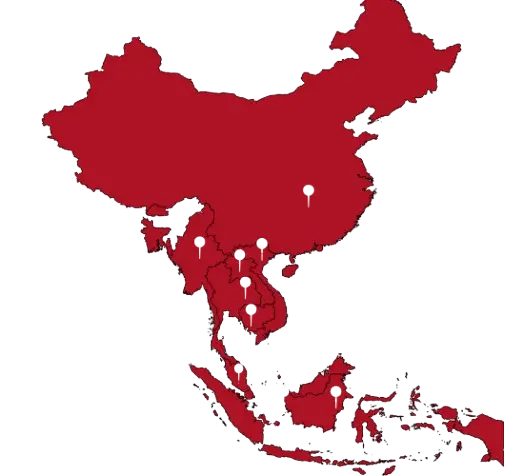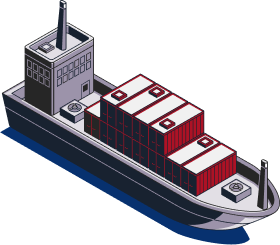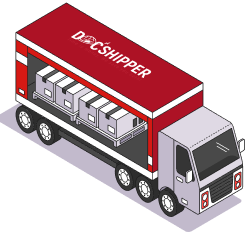Cross-Border Road Transport Between the U.S., Canada, and Mexico
The United States shares two of the busiest and most strategic borders in the world. With Canada, it maintains the longest international boundary on the planet. With Mexico, it manages the most frequently crossed land border globally. DocShipper U.S. provides specialized cross-border trucking solutions that ensure your freight moves seamlessly between these markets, with full visibility and support at every step.
6100 +
Clients9200 +
Operations230 +
K CBM Chartered4.8 +
Customer SatisfactionAn Integrated Network for Cross-Border Transport in North America
With over a decade of experience in international shipping, DocShipper U.S. supports cross-border operations across both northern and southern borders. Every day, goods worth over $2.6 billion are traded with Canada, while Mexico accounts for more than $600 billion in annual trade. Trucks carry the vast majority of this cargo, with over 30,000 trucks crossing into Canada and 35,000 into Mexico daily. Through our strong partner network and local expertise in customs, documentation, and compliance, we ensure your goods flow smoothly across borders—no matter the complexity of your project.


Key Routes Covered by Our Cross-Border Service
We provide FTL (Full Truckload) and LTL (Less-than-Truckload) trucking services adapted to all volumes and industries. Our routes cover major economic hubs across the U.S., Canada, and Mexico.
- U.S. ↔ Canada: New York / Detroit to Toronto / Montreal
- U.S. ↔ Canada: Seattle to Vancouver
- U.S. ↔ Mexico: Laredo / El Paso to Monterrey / Mexico City
- U.S. ↔ Mexico: San Diego to Tijuana / Guadalajara
For Every Challenge, We Have the Solution
The challenges of cross-border transport in Asia are numerous, but we know how to navigate them.
THE CHALLENGE
U.S. cross-border trade faces strict customs and documentation requirements. Differences between CBP (U.S.), CBSA (Canada), and SAT (Mexico) can cause delays.
THE SOLUTION
We assign licensed customs brokers to manage all paperwork, from import declarations to certificates of origin.
Your cargo is pre-cleared whenever possible, minimizing border delays.
THE CHALLENGE
Mexican drivers usually cannot operate inside the U.S., and vice versa. This often requires transloading or relay drivers at the border.
THE SOLUTION
DocShipper coordinates secure cargo transfers with bonded facilities, using LoLo (Lift-On/Lift-Off) methods to minimize handling risks.
THE CHALLENGE
Borders like Laredo (Mexico) or Windsor (Canada) often face heavy traffic, especially during peak trading periods.
THE SOLUTION
Through real-time monitoring of traffic flows and partnerships with local carriers, we reroute and adjust capacity quickly to keep goods moving.
THE CHALLENGE
Cargo Security
High-value shipments such as electronics or pharmaceuticals face theft risks, particularly on some Mexican corridors.
THE SOLUTION
We use GPS tracking, vetted drivers, anti-theft devices, and a monitored fleet to ensure maximum security from origin to destination.
Need an Optimized Cross-Border Service?
Contact us now for a personalized quote and discover how DocShipper simplifies U.S.–Canada and U.S.–Mexico trucking.
Why
Choose Our Cross-Border Service?
Local Expertise on Both Borders
We manage shipments through all key U.S.-Canada and U.S.-Mexico crossings, with local agents ensuring smooth coordination and problem-solving on both sides.
Flexibility in Routes and Scheduling
Cross-border trucking offers more departure flexibility than sea or air. We optimize routes and adapt to your deadlines, reducing downtime and maximizing efficiency.
Cost-Effective Solutions
We adapt services to your budget by offering hybrid transport options, including multimodal connections (road + sea, road + rail) that lower overall shipping costs.
Simplified Customs Clearance
Our licensed customs brokers handle documentation, duties, and compliance with U.S. CBP, Canada CBSA, and Mexico SAT regulations. By anticipating requirements, we reduce delays and keep your shipments compliant.
Clients Testimonials
We can't make this up - See why businesses worldwide trust us with their shipments every day.
I contacted DocShipper to organize the import of board games from Asia to Switzerland. Despite my lack of experience in the field and the modest size of my request, my dealings with the staff were always professional and efficient. I received sound advice and the staff always took the time to answer my questions. I look forward to working with DocShipper for the import of my goods and highly recommend their services.

Mavrik Grangier
December 10, 2024
My name is Ad Van Den Bosh. I am a Dutch business man cross-trading in the Far East. I reached Robert Houwayek (DocShipper's representative) to clear a 40HC of greenhouse equipment from Qingdao, and deliver it to Lan Krabue in no time. He suggested that I request a Form E, which I did from the supplier, and was able to enjoy a preferential tariff treatment. DocShipper, a way to help you save both time and money!!

Ad van den Bosch
March 5, 2024
I recently used Docshipper to ship my appliances from Germany to Thailand, and I'm thrilled with the service I received! [...]The team was professional, responsive, and kept me informed every step of the way. The packaging and handling of my appliances were top-notch, and they arrived in perfect condition. I was impressed with the attention to detail and care taken to ensure a safe and successful transport. I really recommend Docshipper for it.

Chemmie Chatuphorn
November 28, 2024
In the event of goods being stuck at customs, Robert [...] is a customs broker you should arguably consider to release your cargo. Once I knew that my scale modeling tools coming from Spain are being withheld at Suvarnabhumi Airport, I resorted to him to release it and handle the last mile delivery. All what he asked me is to send 2 emails to be able to do it! [...] Well guess what, within 48 hours, it was done! I got my parcel at my place in Phuket.

Chan chan
Mar 5, 2024
A vice president caught up in the thick of thin things, an EXW shipment of plumbing supplies for irrigation from Eureka California to Costa Rica is definitely not what I’d like to have on my agenda. Robert’s hang-in-there posture toward any arising challenges in shipping. [...] skillfully handled all US export formalities incl. SED/AES filing, not to mention the sea freight from Oakland POL. Everything ended up working out like a charm!

Dave Sheppard
July 10, 2024
I feel they covered everything. DocShipper shipped a 20- ft Milvan overseas to Laem Chabang for a customer. The team was responsible for shipping the shipping to another country. Having very little knowledge in this area, I didn't know how to organise myself . One week after my arrival on the Asian continent. Marc O. Was available at all times and nearly instant feedback. Made a stressful event much easier and he definitely knows his job.

Anonymous, Indiana
Aug 9, 2023
Ask Questions. Get clear answer.
Not sure if it’s the right solution or have doubts in mind? No problem—just ask us. We’ll guide you honestly, no commitment required.









